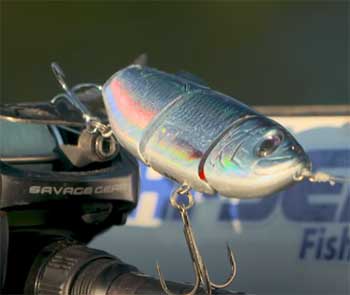Are you an angler trying to find the best bait to land a monster bass?
If yes, then you’re on the right path! A handful of lures will help you get bit, but that’s not the only problem, unfortunately!
You need one that can be cast and fished without much hassle. And with me are two potential candidates. Glide bait has a single joint, while a swimbait can be unjointed or multi-jointed.
The latter moves in a straight line, while the glide lure moves in an s-shaped line. To grasp more distinctive features, stick with me till the end!
A Quick Comparison Table
| Factors To Consider | Glide Bait | Swimbait |
| Type of Joint | Single | Unjointed Multi-joint |
| Retrieval Action | Moves in an s-shaped line | Moves in a straight line |
| Speed | Slow | Fast |
| Rod Type | Super heavy, about 7, 8-inch feet | G Loomis IX Pro 966 rod Stiff and eight-inch |
| Gear Ratio | 7:1:1 | 5:1 |
| Cost | Lower | Higher |
Detailed Differences Between Glide Bait And Swimbait
- Type of Joint

Lures have different joint types to help them catch fish easily and faster.
Glide baits have a single joint that ensures it pops or pulls the rod leading the hook to move to one side, triggering a target bass to strike.
This joint type is ideal for anglers that are often on the move.
You can cover large waters and not worry about hitting the same spot.
Moreover, the single technique can help you cast a bit further.
In contrast, swim baits can be unjointed or have multiple joints. Usually, the pieces are made separately and then connected.
A quality multi-joint lure can imitate a real fish regardless of the speed or depth of water. The unjointed appeals have a unibody structure to keep them more robust, and their prices are normally down.
- Retrieval Action
A glide bait encompasses a hook, loop, body, and horizontal tail. The body, which has a fish-like structure, is painted to resemble it completely.
During retrieval, the bait moves side to side, forming an s-shaped line. This technique is why a glide hook catches larger fish than other baits, even though they do so in small quantities.
Inversely, swimbaits move in a straight line but in a wiggling way. Most of the boot tails cause the hook to roll and shimmy as it causes water to shift.
However, soft bodies have a wedge-like seat to create a natural swimming movement.
- Speed
Glide baits are the perfect example of the common phrase slow but sure. These lures move slowly to ensure the fishing activity is perfect.
The best thing about a slow-moving jig is that it is more alluring to the bass and allows you to give a more natural vibe. Are you targeting large fish? This is the lure for you as it is less visible and quieter.
Contrarily, swimbaits move faster and more rapidly. They are the best jigs for catching smaller fish in large amounts. And sometimes you don’t have much time; you want to locate the fish as quickly as possible.
Also, this fast-moving gook is the perfect option for warm conditions as fish metabolism is higher, causing them to move fast.
- Rod Type
Small and medium-sized glide baits will get the job done with the help of an extra heavy rod about seven or eight-inch long. But it would be a good call for magnum sizes to increase the rod length and strength.
Conversely, swimbaits work best with the G Loomis IX Pro 966 as they can handle hard and soft baits effectively. So if you are looking for the number one rod, this one is all you can ask for.
Additionally, it should be stiff, weighing around four ounces, and be eight-foot long for optimal results.
- Gear Ratio

Understanding the gear ratios increase your fishing effectiveness.
The appropriate rate for a glide hook is 7:1:1. On the other hand; it’s 5:1 for swimbaits.
A slower reel tends to be more effective, especially in crank baiting.
Better yet, the 5:1 rate is advantageous since it increases your chances of throwing the bait to an optimal depth.
It helps you remain at ease because you are sure of what’s happening with the jig.
- Cost
For glide baits, expect to spend from $12 to $40, depending on the type you want. Based on affordability, these lures are the perfect option.
On the flip side, swimbaits go for $100. Are they pricey compared to other baits? Yes. Are they worth it? Absolutely!
Which Bait Is Worth It?
How worthy a fishing lure is dependent on several factors. What time of the year is it? Large or smaller fish? And there is the cost factor.
Glide bait is less expensive and is best for the fall or winter season. Swimbaits have the best gear ratio and fast speeds and are ideal if you want maximum results.
Also Read: Differences Between Jigging Rap And Shiver Minnow.
Frequently Asked Questions (FAQ)
A glide bait contains a single joint that makes it move slowly from side to side, while a swim bait can have multiple or no joints and progresses more rapidly.
Glide bait will be a good start if you want to mimic large fish like perch or brim. The bait acts like an injured fish to seem like a ready meal for a bass.
First, put the bait in the water. The slow movement ensures the heavy lifting is done and that bass is constantly following the lure. Once the fish bites, reach for its head and quickly wind to avoid giving it leverage.
Opt for a 400-speed reel for large glide baits since you want to make a long cat without putting all your lines out. But for a small or medium-sized glide hook, use a 200 to 300-size reel.
Final Words
Every bit of the glide bait and swimbait analogy is covered, so you can easily pick one of the two. Both lures work like a charm whether you’re a beginner or an expert.
Glide bait is the answer if you want a pocket-friendly lure that can easily trap large fish. However, you don’t want anything less than a swimbait for the best performance, all-weathered jig.
You’re welcome!

